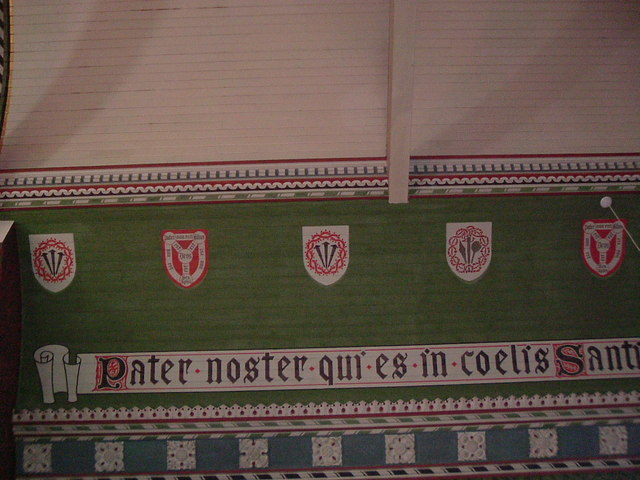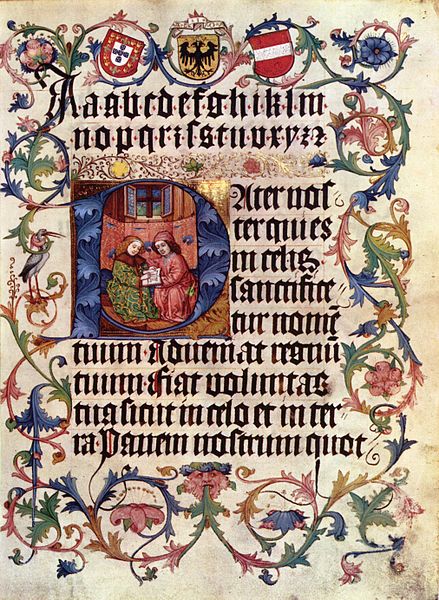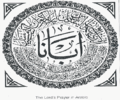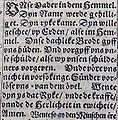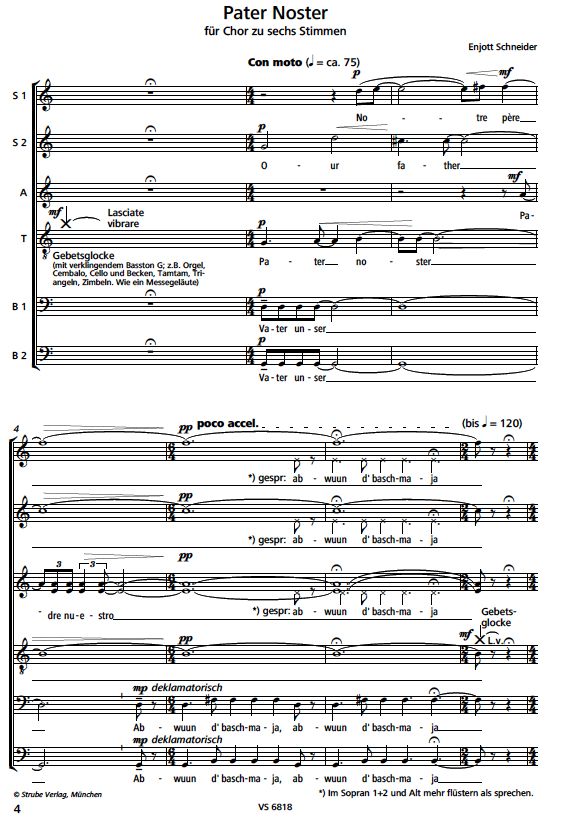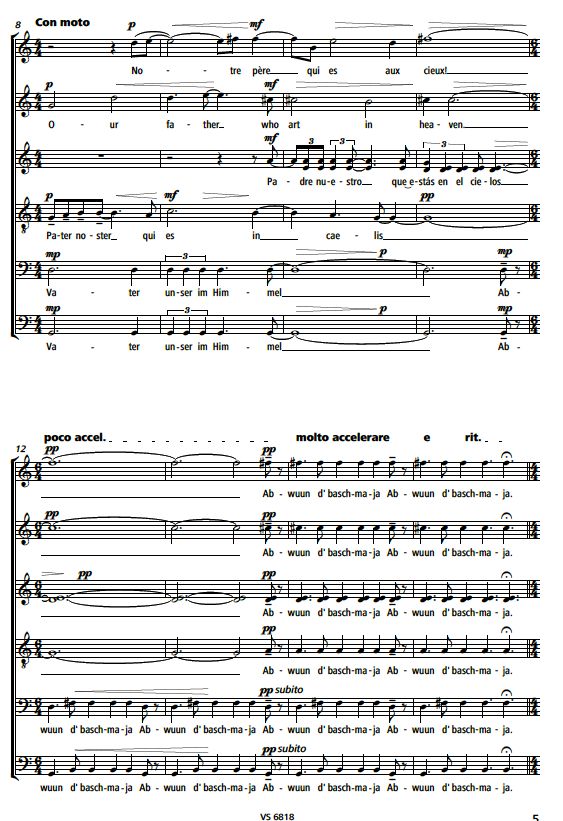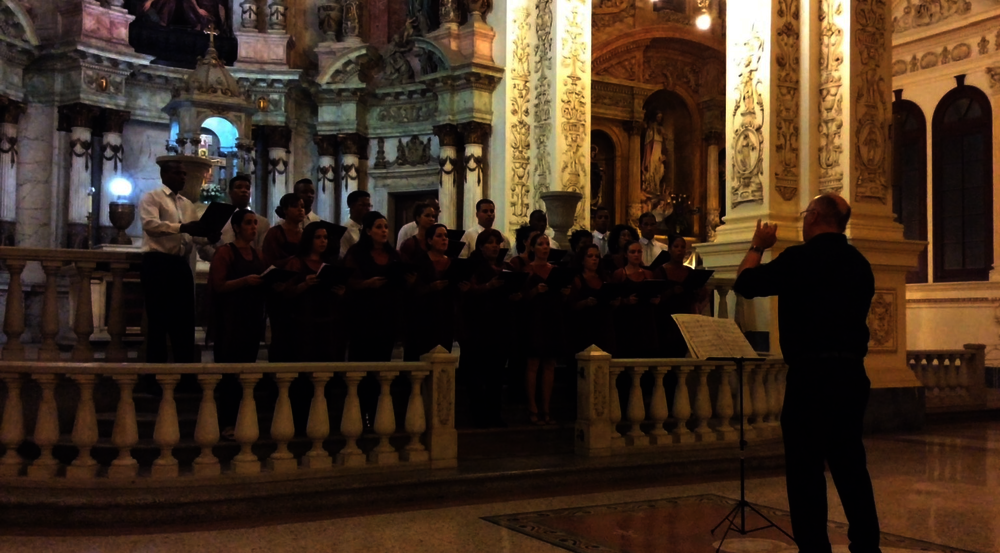Category: Choir / Vocal , Organ / Sacred Music
Duration: 5 minutes
Publisher of notes/sheet music: Strube Verlag Munich , 2014
Instrumentation: Choir with six voices (S1 S2 A T B1 B2) with at least three singers in every pitch/voice. The „Gebetsglocke„ (prayer bell) is a kind of archaic mass chime with 1-3 triangles, cymbals, tam-tam, gong, possibly also low bass sounds of the organ in G, cembalo, double bass or trombone (may sound ethnologic-oriental depending on the used instruments).
Introduction: The „Our Father“ as „The Lord's Prayer“ is based on the Sermon on the Mount in the Gospel of Matthew (Matthew 6, 9-13) and is part of three synoptic gospels. Ever since the 4th century, it has been part of the Roman liturgy and opened the Communion; the sacramental closeness to the breaking of the bread has remained since then. As this prayer is spoken by Christians around the world every day, the idea was born to create a ployglot composition that outlines the coexistence of many different language. In addition to fragments in English, German, French, and Spanish, the Latin version - in combination with the known Gregorian melody - plays a central role due to its historic importance. A special aspect is the inclusion of the Aramaic language, the language in which Jesus Christ once said this prayer. That's how the spiritual room opens up and gives room to touching authenticity with surprises in store - as the Aramaic language has different levels of meaning and is organised with a poetic ambiguity: Be it the gender-neutral chant „abwuun“, referring to father or mother; or be it the „lachma“ which means 'bread' as well as 'realization' and the breaking of the bread was more about allaying spiritual hunger than physical hunger. It is also remarkable that „l’nesjuna“ does not necessarily refer to „temptation“ as we would define it today, but (according to the scientist Neill Douglas-Klotz) it refers to „inner restlessness that distracts us from our actual purpose in life“.
This cannot be the place to weigh up theologic opinions. What remains of significance is the fact that the „Lord's Prayer“ retains the aura of 2000 years of lived religiousness and that we feel connected to this ancient wisdom of Christianity - across all cultures and exegetical options.
Text:
Pater noster / Vater unser / Our Father /Notre Père / Padre nuestro / Abwuun d’baschmaja
Pater noster, qui es in caelis / Vater unser im Himmel / Our Father who art in heaven / Notre Père qui es aux cieux / Padre nuestro que estás el cielos /
Abwuun d’baschmaja
Nitkadisch schmach / sanctificetur nomen tuum / Dein Name werde geheiligt / Hallowed be Thy name / Que ton nom soit sanctifié / santificado sea tu nombre
Tehteh malkutach / Adveniat regnum tuum / Dein Reich komme / Thy kingdom come / que ton règne vienne / venga a nostros tu reino / Tehteh malkutach
Fiat voluntas tua sicut in caelo et in terra /
Nech-wey Zev-janach aikana d’baschmaja af b’arha /
Que ta volonté soit faite sur la terre comme au ciel /
Thy will be done on earth as it is in heaven /
Dein Wille geschehe wie im Himmel so auf Erden
Panem nostrum cotidianum da nobis hodie / Et dimitte nobis debita nostra / Sicut et nos dimittimus debitoribus nostris.
Und führe uns nicht in Versuchung / mais délivre nous du mal / For Thy is the kingdom / et poder y la gloria por los siglos de los siglos. Amen.
Pater noster / Vater unser / Our Father /Notre Père / Padre nuestro / Abwuun d’baschmaja
Pater noster, qui es in caelis / Vater unser im Himmel / Our Father who art in heaven / Notre Père qui es aux cieux / Padre nuestro que estás el cielos /
Abwuun d’baschmaja
Dedication: dedicated to my friend, Kunibert Schäfer
World premiere: 30.05.2014, Catholics Day Regensburg 2014
Performers at world premiere: with the New Chamber Choir Regensburg and the Raselius Choir, cond.: Kunibert Schäfer
